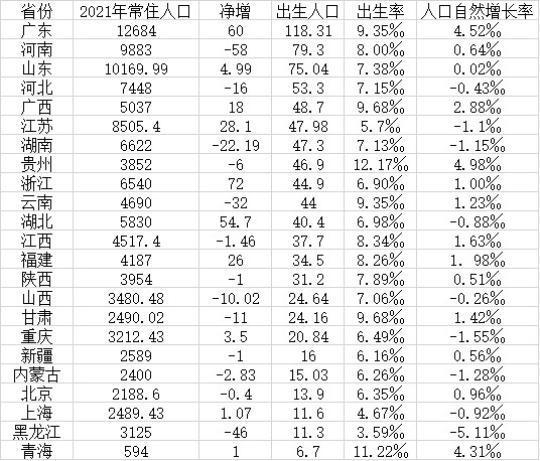After the National Bureau of Statistics released the 2021 population data, local data have also been released in various places.
According to Yicai statistics, as of April 3, 27 provinces have released resident population data for 2021.
Among them, 23 provinces have released data on the birth population in 2021. Among them, 4 provinces had more than 500,000 births last year, and Guangdong was the only province with more than 1 million births. In terms of birth rate, only 2 provinces had a birth rate of more than 1%. (ie 10 per thousand), 9 provinces experienced negative natural population growth.
Table: Birth population data in 23 provinces (population unit: 10,000 people. Data source: CBN reporters based on local statistical bulletins, statistical yearbooks and other public data)
Among them, the latest statistics released by Guangxi show that by the end of 2021, the resident population of the whole district is 50.37 million, an increase of 180,000 over the end of the previous year, of which the urban population is 27.746 million, accounting for 55.08% of the resident population (the urbanization rate of the resident population). , an increase of 0.88 percentage points over the end of the previous year.
The annual birth population was 487,000, with a birth rate of 9.68‰; the death population was 342,000, with a death rate of 6.80‰; the natural growth rate was 2.88‰.
According to the data of the "Guangxi Statistical Yearbook 2021", the first financial reporter found that this is the first time that the birth population in Guangxi has been lower than 500,000 in 44 years (the statistical yearbook has published the data of the birth population in Guangxi over the years since 1978), and it is also the first time that the birth rate of Guangxi is low. at 1% (ie ten thousandths).
In terms of total birth population, there are 4 provinces with more than 500,000 births in 2021. Among them, Guangdong, the largest economic province, has a birth population of 1,183,100, making it the only province with more than 1 million births.
After Guangdong, Henan and Shandong ranked second and third, with a birth population of 793,000 and 750,400 respectively.
Hebei's birth population also surpassed the 500,000 mark at 533,000.
Guangxi, Jiangsu, Hunan, Guizhou, Zhejiang, Yunnan and Hebei all have between 400,000 and 500,000 births in 2021.
In terms of birth rate, the data shows that among the 23 provinces, only 2 provinces have a birth rate higher than 1% (ie 10 per thousand), which are Guizhou and Qinghai, and Guangxi and Gansu are tied for third with 9.68‰.
Yunnan and Guangdong tied for fifth with 9.35‰.
On the whole, places with a high birth rate are mainly concentrated in some places with a low urbanization rate in the western and central parts of the country.
However, two economically developed coastal provinces with high urbanization rates like Guangdong and Fujian also have relatively high birth rates.
Influenced by traditional clan culture and other factors, Guangdong and Fujian have a relatively high willingness to bear children.
Taking Fujian as an example, Ding Changfa, an associate professor of the Department of Economics at Xiamen University, analyzed Yicai that the southern part of Fujian, such as Quanzhou and Putian, has a relatively high willingness to give birth.
"These places are dominated by the private economy and business groups. Many people have great careers and good economic conditions, and they have a strong ability to bear more children."
In Guangdong, on the one hand, Chaoshan and other places have a relatively high willingness to bear children. On the other hand, Guangdong has the largest population inflow. The inflow population is mainly young and middle-aged, and the population of childbearing age is relatively large.
From the perspective of natural population growth rate, among the 23 provinces, 9 provinces, autonomous regions and municipalities will be negative in 2021, including Hebei, Jiangsu, Hunan, Hubei, Shanxi, Chongqing, Inner Mongolia, Shanghai, and Heilongjiang.
Among them, including Jiangsu, Hubei, Hunan, Inner Mongolia and Shanxi, the natural population growth rate turned negative for the first time in recent decades.

